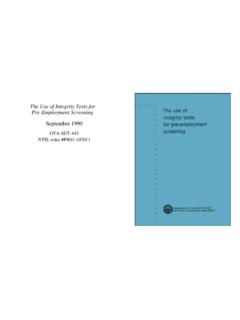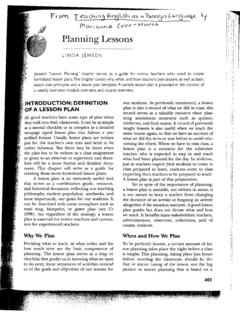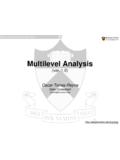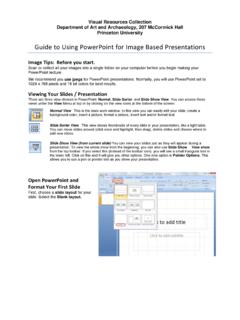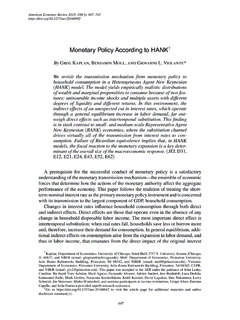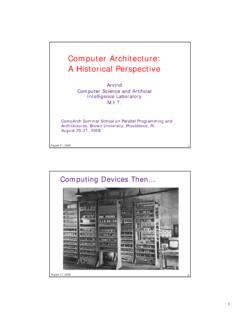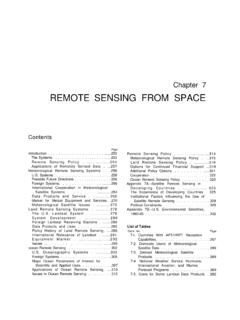Transcription of The Pulp and Paper Making Processes - Princeton
1 Chapter 2 The pulp and Paper MakingProcessesCONTENTSPageTHE pulp AND Paper MILL..17 Steps in the pulp and Papermaking ..18 Pulping .. View of Papermaking From Chemical pulp by the Kraft Groundwood pulp Mill Flow..Refiner Groundwood pulp MillSulfite pulp Mill ..Table2-1. MajorCommercial Wood-PulpingProcess..TableTechnologies ..Page..1921..22..25 Page..18 Chapter 2 The pulp and Paper Making ProcessesThe modem manufacture of Paper evolved froman ancient art first developed in China, ca. 105 the modem product differs considerablyfrom its ancestral materials, papermaking retainsdistinct similarities to the Processes developed byTs ai Lun in the Imperial Chinese Court. Inprinciple, Paper is made by: 1) pulping, to separateand clean the fibers; 2) beating and refining thefibers; 3) diluting. to form a thin fiber slurry,suspended in solution; 4) forming a web of fibers ona thin screen; 5) pressing the web to increase thedensity of the material; 6) drying to remove theremaining moisture; and 7) finishing, to provide asuitable surface for the intended end and Paper are made from cellulosic fibers( , fibers from trees) and other plant materials,although some synthetic materials may be used toimpart special qualities to the finished product.
2 Mostpaper is made from wood fibers, but rags, flax,cotton linters, and bagasse (sugar cane residues) arealso used in some papers. Used Paper is alsorecycled, and after purifying and sometimes de-inking, it is often blended with virgin fibers andreformed again into Paper . Other products madefrom wood pulp (cellulose) include diapers, rayon,cellulose acetate, and cellulose esters, which areused for cloth, packaging films, and is composed of: 1) cellulose, 2) lignin, 3)hemicellulose, and 4) extractives ( , resins, fats,pectins, etc.). Cellulose, the fibers of primaryinterest in papermaking, comprises about 50 percentof wood by ovendry weight. Lignin, which cementsthe wood fibers together, is a complex organicchemical the structure and properties of which arenot fully understood, It is largely burned for thegeneration of energy used in pulp and Paper the chemistry of lignin becomes better under-stood, what is now mostly a waste product used forfuel (some is converted to chemical products) couldbecome a valuable feed stock for new pulping process is aimed at removing asmuch lignin as possible without sacrificing fiberstrength, thereby freeing the fibers and removingimpurities that cause discoloration and possiblefuture disintegration of the Paper .
3 Hemicellulose issimilar to cellulose in composition and function. Itplays an important role in fiber-to-fiber bonding inpapermaking. Several extractives ( , oleoresinsand waxes) are contained in wood but do notcontribute to its strength properties; these too areremoved during the pulping fiber from nearly any plant or tree can be usedfor Paper . However, the strength and quality of fiber,and other factors that can complicate the pulpingprocess, varies among tree species. In general, thesoftwoods ( , pines, firs, and spruces) yield longand strong fibers that impart strength to Paper andare used for boxes and packaging. Hardwoods, onthe other hand, generally have shorter fibers andtherefore produce a weaker Paper , but one that issmoother, more opaque, and better suited for print-ing. Both softwoods and hardwoods are used forpapermaking and are sometimes mixed to provideboth strength and printability to the finished pulp AND Paper MILLA lthough there are several chemical and mechani-cal pulping methods used for delignifying wood(table 2-l), separating fibers, and removing discol-oration, all integrated pulp and Paper mills involvethe same general steps in the manufacture of pulpand Paper .
4 These steps include: 1 ) raw materialpreparation ( , debarking and chipping); 2) me-chanical and/or chemical separation of the woodfibers [ , grinding, refining, or digestion (cook-ing)] to dissolve the lignin and extractives; 3)removal of coloring agents (primarily residual lig-nin) by bleaching; and 4) Paper formation typical layout of a mill using the kraft chemicalpulping process is shown in figure 2-1. Mechanical,semichemical, and sulfite pulp mills differ in detail,particularly in wood preparation, fiber separation,and bleaching, but many of the downstream refining,bleaching, and papermaking Processes are addition to the primary steps in pulp and papermanufacture, each mill has extensive facilities toIA, H, Nlss~, p~p~~, WOO~ Ifs ~(ruC~~e U~~ p?ope?(ies, , Wangaard (cd.) (University Park, PA: Pennsyivtia State University 198 1)! P 3~ l Technologies for Reducing Dioxin in the Manufacture of Bleached Wood PulpTable 2-l Major Commercial Wood-Pulping TechnologiesPulp grades useWood typeEnd-product useChemical pulps:sulfite pulp .
5 Softwoods and hardwoodsFine and printing papersKraft sulfate pulp .. Softwoods and hardwoodsBleached-printing and writing papers, paperboardUnbleached-heavy packaging papers, pulp .. SoftwoodS and hardwoodsViscose rayon, cellophane, acetate fibers, and filmSemichemical pulps:Cold-caustic process .. Softwoods and hardwoodsNewsprint and groundwood printing papersNeutral sulfite process .. HardwoodsNewsprint and groundwood printing papersMechanical pulpsStone groundwood , .. SoftwoodsCorrugating mediumRefiner mechanical (RMP) .., .. SoftwoodsNewsprint and groundwood printing papersThermomechanical (TMP) ..SoftwooodsNewsprint and groundwood printing papersSOURCE: Modifhdfrom George H. Soyd Ill and Chad E. Srown, Paper /~sfFy: ~tbok b Market Pu/p (New York, NY: KiddM, Peabody & (h, 19S1 ), p. and reclaim chemical agents used in thepulping process; collect, process, and bum ligninand waste wood to produce energy; and remove andtreat wastes from process water for release into in the pulp and Papermaking ProcessRaw Material PreparationWood received at a pulp mill may be in severaldifferent forms, depending on the pulping processand the origin of the raw material.)
6 It maybe receivedas bolts (short logs) of roundwood with the bark stillattached, as chips about the size of a half-dollar thatmay have been produced from sawmill or veneermill waste or pre-chipped from debarked roundwoodelsewhere, or as waste sawdust in the case of somepulping roundwood is used, it is first debarked, usuallyby tumbling in large steel drums where wash watermay be applied. The debarked wood bolts are thenchipped in a chipper if the pulping process calls forchemical digestion or are fed into a grinder in thecase of some mechanical pulps. Chips are screenedfor size, cleaned, and temporarily stored for SeparationThe fiber separation stage is the point at which theseveral pulping technologies diverge. In kraft chemi-cal pulping, the chips are fed into a large pressurecooker (digester), into which is added the appropri-ate chemicals (white liquor). The chips are thencooked (digested) with steam at specific tempera-tures long enough to separate the fibers and partiallydissolve the lignin and other digesters operate continuously with a con-stant feed of chips (furnish) and liquor, others arecharged intermittently and treat a batch at a digestion, the cooked pulp (brown stock) isdischarged into a pressure vessel (blow tank) wherethe steam and volatile materials are siphoned cooking liquor, that by this time has turned darkbrown from the dissolved lignin (black liquor), isreturned to the chemical recovery cycle, In thechemical recovery plant, the lignin in the blackliquor is burned for the cogeneration of energy, andthe chemicals are recovered, purified, reconstituted,and returned to the digester as white liquor for brown stock containing the recovered fibers(having the consistency of cooked oatmeal)
7 Iswashed with water, screened to remove undigestedwood, and cleaned to remove other foreign is then ready for bleaching and further separation in mechanical pulping is lessdramatic. In the stone groundwood process, de-barked logs are forced against rotating stone grind-ing wheels that are constantly washed by a stream ofwater. The ground pulp is then screened to removecourse debris, thickened, and stored for the Paper - Making are used to produce refiner pulp andthermomechanical pulp . In both Processes the chipsare ground by passing them through rapidly rotatingChapter 2 The pulp and Paper Making Processes l 19 Figure 2-1-Overall View of Papermaking From Chemical pulp by the Kraft ProcessContinuous digesterIIWhite liquorclarifierWash waterIIStripped condensatesASOURCE: Envirorwnent Ontario, Srop@ng Water Poflutioft Al Its Source (Toronto, OntarIO: Ministry of the Environment, 1988).
8 20 l Technologies for Reducing Dioxin in the Manufacture of Bleached Wood Pulpdisk grinders. Thermomechanical pulp is refined(ground) under pressure after the chips are pretreatedwith steam (chemical thermomechanical pulp useschemicals and steam for pretreatment). After furtherrefining in a second stage, the pulp is screened,cleaned, and most of the process water is removed inpreparation for or BrighteningSince the raw pulp (brown stock) still contains anappreciable amount of lignin and other discolora-tion, it must be bleached to produce light colored orwhite papers preferred for many products. Bleachingis normally done in several stages (multistagebleaching). Through chlorination and oxidation thefibers are further delignified by solubilizingadditional lignin from the number of bleaching agents may be used andare applied in a stepwise fashion within a bleachingsequence.
9 These include chlorine gas, chlorinedioxide, sodium hypochlorite, hydrogen peroxide,and oxygen. Between bleaching treatments, a strongalkali (usually sodium hydroxide) is used to extractthe dissolved lignin from the surface of the bleaching agents and the sequence in which theyare used depend on a number of factors, such as therelative cost of the bleaching chemicals, type andcondition of the pulp , desired brightness of the paperto be produced, and sometimes in response toenvironmental guidelines and of mechanical pulp is much differentthan that for chemical pulp . Mechanical pulpingleaves the lignin and the cellulose intact, whereas thepurpose of chemical pulping is to chemically sepa-rate the lignin from the cellulose fibers and removeit from the pulp . A major advantage of mechanicalpulping is the high yields of pulp that can beachieved from a given volume of wood. Therefore,bleaching or brightening of mechanical pulps isdesigned to minimize the removal of the lignin thatwould reduce fiber used for bleaching mechanical pulpsselectively destroy coloring impurities but leave thelignin and cellulosic materials intact, These includesodium bisulfite, sodium or zinc hydrosulfite (nolonger used in the United States), calcium or sodiumhypochlorite, hydrogen or sodium peroxide, and theSulfur Dioxide-Borol Process (a variation of thesodium hydrosulfite method).
10 Originally, much ofthe mechanical pulp was not bleached, but thebleaching of groundwood has increased and im-proved technology now enables bleached ground-wood pulp to be used for printing papers, tissues, bleached or unbleached pulp may be furtherbeaten and refined to cut the fibers and roughen thesurface of the fibers (fibrillate) to improve formationand bonding of the fibers as they enter the papermachine. Before entering the Paper machine, wateris added to the pulp slurry to make a thin mixturenormally containing less than 1 percent fiber. Thedilute slurry is then cleaned in cyclone cleaners andscreened in centrifugal screens before being fed intothe wet end* of the Paper -forming the Paper Making process, the dilute stockpasses through a headbox that distributes the fiberslurry uniformly over the width of the Paper sheet tobe formed. The web of fiber that will make thenew Paper sheet is formed on a continuously movingbronze or polymer screen (Fourdrinier) or betweentwo such wire screens.

